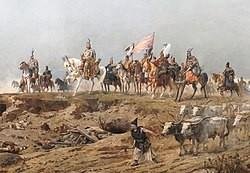Main articles: Pannonian basin before the Hungarians and Hungarian prehistory

Grand Prince Árpád crossing the Carpathians. A detail of the Arrival of the Hungarians, Árpád Feszty's and his assistants' vast (1800 m²) cycloramic canvas, painted to celebrate the 1000th anniversary of the Magyar conquest of Hungary, now displayed at the Ópusztaszer National Heritage Park in Hungary.
The oldest archaeological site in Hungary is Vértesszőlős, where palaeolithic Oldowan pebble tools and an early human fossil nicknamed "Samu" (a 350,000-year-old Homo Erectus) were discovered in 1965.
The Roman Empire conquered territory west of the Danube River between 35 and 9 BC. From 9 BC to the end of the 4th century AD, Pannonia, the western part of the Carpathian Basin, was part of the Roman Empire. In the final stages of the expansion of the Roman empire in the early centuries of the first millennium AD, the Carpathian Basin fell under the Mediterranean influence of Greco-Roman civilization for a short period – town centers, paved roads, and written sources were all part of the advances put to an end by the "Migration of peoples" that characterized the Early Middle Ages in Europe.
After the Western Roman Empire collapsed in the 5th century AD under the stress of the migration of Germanic tribes and Carpian pressure, the Migration Period continued to bring many invaders into central Europe. Among the first to arrive were the Huns, who built up a powerful empire under Attila the Hun in 435 AD. Attila was regarded in past centuries as an ancestral ruler of the Hungarians, but this is now considered to be inaccurate.[1] It is believed that the origin of the name "Hungary" does not come from the Central Asian Hun nomadic invaders, but rather from Magyar tribes that were part of a Bulgar alliance called "On-Ogur", which in Bulgar Turkic meant "(the) Ten Arrows".[2] They entered what is now Hungary in the 7th century AD[citation needed].
After Hunnish rule faded in the 6th century AD, the Germanic Ostrogoths, Lombards and Slavs came to Pannonia, whereas the Gepids had a presence in the eastern part of the Carpathian Basin for about 100 years. In the 560s the Avars founded the Avar Khaganate,[3] a state that maintained supremacy in the region for more than two centuries and had the military power to launch attacks against its neighboring empires. The Avar Khaganate was weakened by constant wars and outside pressure, and the Franks under Charlemagne managed to defeat the Avars to end their 250-year rule. In the middle of the 9th century, the Slavic Balaton Principality, also known as Lower Pannonia, was established by the Franks as a frontier march when they destroyed the Avar state in the western part of the Pannonian plain, however this vassal state was destroyed in 900 by Hungarian tribes
Hi @ajmallik Thanks for sharing this content with us. Hope to see more from you 👍 😃